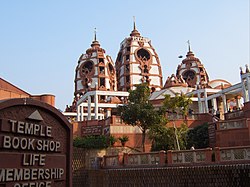| ISKCON New Delhi | |
|---|---|
Sri Sri Radha Parthasarathi Mandir | |
 Outer View of Temple | |
| Religion | |
| Affiliation | Hinduism |
| District | New Delhi |
| Deity | Radha Parthasarathi (Krishna and Radha) |
| Location | |
| Location | Hare Krishna Hills, East of Kailash |
| State | Delhi |
| Country | India |
| Geographic coordinates | 28°33′29″N77°14′36″E / 28.55806°N 77.24333°E |
| Architecture | |
| Type | Hindu temple architecture |
| Completed | 1998 |
| Website | |
| iskcondelhi | |
Sri Sri Radha Parthasarathi Mandir, generally known as the ISKCON Temple Delhi, is a Hindu temple of Krishna and Radha in the form of Radha Parthasarathi. The Temple was inaugurated on 5 April 1998 by the then Prime Minister of India, Atal Bihari Vajpayee [1] in the presence of former Chief Minister of Delhi, Sahib Singh Verma, and Sushma Swaraj. It is located at Hare Krishna Hills (near Nehru Place), in the East of Kailash area of New Delhi, India.





